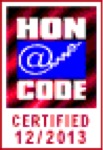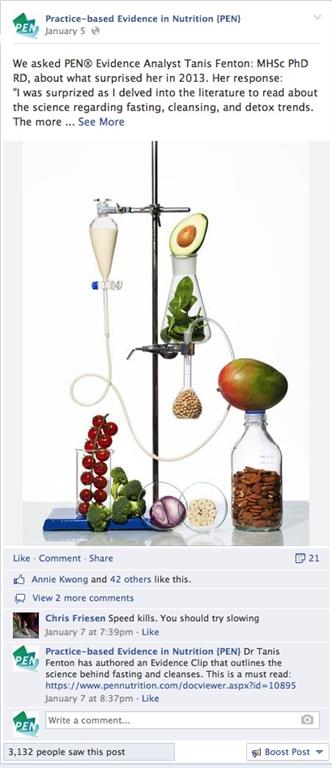PEN eNews 3(5) February 2014
PEN
® eNews is a monthly e-newsletter shared with the global PEN Community and created to help dietitians position themselves as leaders in evidence-based nutrition practice. In addition, users of the PEN System will find articles on the new evidence, resources and features available and how to maximize one's use of PEN.

Steering the Train Back to Nutritional Sciences
Dietitians are making a media splash in the first half of 2014! Around the world, the profile of dietitians will be raised through various advocacy campaigns, designed to address “local” nutrition issues (though I think we all face similar nutrition issues):
 Our colleagues down under will lead the media splash in February with their 7th Australia’s Healthy Weight Week. This week is part of the DAA’s comprehensive obesity strategy, helping to address overweight and obesity in Australia.
Our colleagues down under will lead the media splash in February with their 7th Australia’s Healthy Weight Week. This week is part of the DAA’s comprehensive obesity strategy, helping to address overweight and obesity in Australia. - Our Canadian colleagues will follow next with March’s Nutrition Month. This year’s theme is Simply Cook & Enjoy, inspiring Canadians to return to cooking basics and to involve children and youth in food preparation.
- In June, our UK colleagues will celebrate the inaugural Dietitian’s Week, as well as their on-going work with the Trust a Dietitian Campaign, highlighting the work and value of dietitians and the dietetic profession as a whole in the UK.
While each campaign is different, it is exciting to see how our common foundation of nutritional research is being digested, packaged and translated into different messages.
With the consumer interest in food and nutrition, it feels like a big “nutritional train” has left the station. I am glad that dietitians are not only on the train, but that we have campaigns like the above that profile dietitians as the drivers, helping to keep the train on track.
In this issue of PEN eNEws 3(5), we have articles that will help you steer the “nutritional train”, that you are a part of, back to nutritional science. Our PEN
® Year in Review shares our reflections of surprising nutritional evidence uncovered in the past year.
I May Know…I Mean I Know Something About Nutrition shows dietitians three ways to improve their nutrition communications. How do I…customize PEN
® client handouts? helps you put your organization’s logo on PEN
® handouts, allowing you to focus on using evidence-based handouts, rather than spending the time creating them. This and more in PEN eNews 3(5).
Kristyn Hall MSc, RDEditor, PEN® eNews
PEN
® eNews may contain links to other external websites.
PENnutrition.com is not responsible for the privacy practices or the content of such external websites. Dietitians of Canada, Dietitians Association of Australia, Dietitians New Zealand and The British Dietetic Association do not endorse the content, products or services on other websites.
PEN® Website Achieves International Certification
The Practice-based Evidence in Nutrition® (PEN) Global team takes great pleasure in announcing that the PEN website earned Health on the Net (HON) Code of Conduct certification. HON is a non-profit, non-government organization dedicated to promoting credible health information on the Internet. The PEN website proudly joins other websites such as Cochrane.org and Mayoclinic.com as a source of trustworthy online health and nutrition information.
To receive HONcode certification, a website undergoes scrutiny by HON officials and must comply with criteria established by HON (see the eight principles to achieve certification below). There is ongoing surveillance of the website and a systematic biennial review. There is no cost associated with the certification - only the time and effort required to ensure your site meets the criteria. HON certified sites receive the ‘HON Code of Conduct’ logo to identify certification status.

The PEN website meets the eight principles set by HON to achieve certification:
- Authority: All medical information presented on your web site must be attributed to an author and his/her training in the field must be mentioned.
- The PEN website identifies all authors and reviewers with credentials noted within each Knowledge Pathway under Pathway Contributors. The PEN content team and advisory committees are described at: About PEN
- Complementarity: A statement clearly declaring that the information on the website is not meant to replace the advice of a health professional has to be provided.
- The PEN website clearly states that the information it contains “should be used to complement, not replace sound clinical judgment.“
- Confidentiality: Respect the privacy of site users
- Attribution: Cite the sources and dates of medical information
- All knowledge objects, e.g. questions, tools and resources, toolkits etc., in the PEN database are date stamped with last updated date, which reflects date when review and or updating has occurred.
- All practice guidance in the PEN website is referenced according to standardized procedures outlined in the PEN Writer’s Guide and PEN Style Guide (PEN access required).
- Justifiability: Justification of claims / balanced and objective claims
- PEN Protocol for Finding the Evidence
In developing the content for the PEN website, validated and refined filtered information sources including synopses, well-conducted systematic reviews (such as Cochrane Reviews) and reputable practice guidelines form the basis for the evidence synthesis. Where filtered sources fail to address practice questions, PubMed is used to identify relevant and scientifically valid articles for analysis and synthesis. Extensive web searches for grey literature and unpublished resources also are used to find other relevant materials.
- Evidence Grading
Key practice points in the PEN website have been assigned an evidence grade by the Knowledge Pathway author using an Evidence Grading Checklist.
- Transparency: Accessibility, provide valid contact details
- The PEN web site is set to be available during core business hours (to support two Canadian Dietitian Contact Centres) and achieves this target 99.9% of the time. Maintenance (migrating changes to production) is scheduled once a month, on the last weekend of the month, to minimize user downtime and interruptions.
- Contact Us is available on every PEN web page. Customer Service response times are monitored to ensure the target of 85% of contacts are addressed in less than 72 hours. PEN Client Services consistently meet or exceed this target.
- Financial disclosure: Provide details of funding
Funding
It is essential that the development of evidence-based tools for practice guidance be not biased through the influence of commercial entities that may stand to benefit from the service and its recommendations. As such, DC does not accept corporate sponsorship for the production or updating of practice guidance provided in the knowledge pathway content of PEN. DC does not host or receive funding from advertising or from the display of commercial content on the PEN website. All PEN authors and reviewers are required to complete a Declaration of Affiliations and Interests Form that is kept on file with Dietitians of Canada.
- Advertising: Clearly distinguish advertising from editorial content
- As above: DC does not accept corporate sponsorship for the production or updating of practice guidance provided in the knowledge pathway content of the PEN® system. DC does not host or receive funding from advertising or from the display of commercial content on the PEN® website.
- See About PEN
Please join the PEN® Global Team in spreading the news about our success in achieving the HONcode as a reliable and credible health and nutrition web site.
Written by Jayne Thirsk, RD, PhD, FDC
PEN® Director
Dietitians of Canada
Welcoming Ireland to the PEN® family
On December 4th we welcomed the dietitians in Ireland to the PEN® family. The INDI (Irish Nutrition and Dietetic Institute) annual general meeting in October launched PEN to the membership, with a presentation by Pauline Douglas from the BDA. Such excitement was raised by this meeting that INDI members were enthusiastically discussing PEN at clinical meetings in the UK all during the run up to the launch.
On launch day there were 17 Irish resources available and since then Irish dietitians have contributed to reviews. In the first month since launch, there have been 785 visits to PEN
® by Irish dietitians. Bravo - we hope you like what you found, come back to the database often to find answers to your practice questions, and tell all your colleagues! We also welcome feedback and suggestions via contact us
http://www.pennutrition.com/contact.aspx or via the INDI representative, Claire Moreau.
Claire Moreau will be joining the newly formed BDA PEN® advisory committee and will be the link between the BDA and Irish Dietitians. The BDA and the wider PEN® collaboration look forward to working further with INDI and hearing from Irish dietitians what they value most about PEN®.
What's New in PEN®
Below is a quick glance at some of the new and updated content in PEN®. Look for the new and updated symbols in PEN® to see more new and enhanced content!
New Knowledge Pathways
Updated Knowledge Pathways
New Practice Questions
Updated Practice Questions
News-making Evidence
Evidence Clip
Other
Professional Tools
Client Tools
What’s New in the PEN® Database?
Each year, the PEN® database grows in breadth and depth. Here is how we grew in 2013:
• 5 New Knowledge Pathways
• 14 Updated Knowledge Pathways
• 26 New Practice Questions
• 140 Updated Practice Questions
• 171 New Client Tools
• 26 Updated Client Tools
• 168 New Professional Tools
• 128 Updated Professional Tools
At the end of 2013, the following was available to PEN® users:
• 172 Knowledge Pathways
• 1075 Practice Questions
• 1150 Client Tools and Resources
• 1075 Professional Tools and Resources
You are there to support your clients. We are here to support your practice. We look forward to answering your practice-based questions in 2014!
How do I…customize PEN Client Handouts?
Written by Lisa Koo, RD PEN Quality Assistant 
The PEN® Handout Collections are a collection of client handouts ranging in topic from Health Condition/Disease, Healthy Eating/Lifestyle, PEN® Food Allergy, to Culturally Adapted and Translated Handouts.
PEN® Handouts in the Collections are aligned with PEN® Evidence, and are designed to help “transfer” this evidence into practical, action-oriented steps. In this way, the PEN® client handouts help save you time since you don’t have to research the literature and develop a handout consistent with this literature - we have done this for you. The PEN® Handout Collections also saves you time because you can see the wide variety of PEN® client handout topics available in the database.
As part of your PEN® subscription, you can use these handouts with your clients. You can also add in your own organizational logo and add in your organization’s contact information to the Distributed By box - right on the handout! Read on to find step-by-step instructions on how PEN® users can customize PEN® Handouts in the PEN® Handout Collections. Please note: This option is only available to PEN users who have an individual or group subscription. Site license users can email a handout to clients using the “Customize and Share this Resource” but they can only customize the message, and not add a specific logo.
How to customize PEN® Client Handouts
1) When you view a handout from the PEN® client handout collection, click on the button underneath labeled “Customize and Share this Resource”.
2) A pop-up window will appear that will allow you to enter your email address, your client’s email address, a personal message and your contact information. You can also choose whether or not to include your handout distribution image (such as an organization’s logo).
3) Click on the ”PDF Preview” button. The handout will preview with your contact information in the “Distributed by” box.
4) When you click on the “Send“ button the handout will be sent to your client with your contact information included in the “Distributed by” box.
How to save a handout distribution image onto your PEN® user profile
You can save a handout distribution image (e.g. your organization’s logo or health clinic logo) for use in the “Distributed by” box on your handout.
1) Click on the “My Profile” tab on the top right hand corner of the PEN® screen.
2) Click on the button labeled “Edit Preferences”.
3) Under the Edit Preferences section, you can choose a file to upload. The image must be a gif, jpeg, or png file and be less than 200K in size. The ideal dimensions of the image are 300 x 100 pixels (width x height).
5) Once you have chosen the file you want to use, click the “Save” button. You have now saved the image to your profile. The image will now automatically appear in your preferences.
When you go to Customize a handout, your handout distribution image will be automatically checked off and will be inserted with your contact information.
Just a reminder:
To remain consistent with an ever-evolving evidence base, the PEN
® handouts are frequently updated. We encourage you to print out what you need as you need them, rather than printing off several to keep on-hand. Printing off the handouts as you need them helps to ensure you are giving out the most up-to-date version. You can mark the handout as a
PEN® Favourite for quick access in the future.
For more information about the PEN® Client Handouts, click here.
We love to hear from our users. If you have any questions about this article, please contact me at lisa.koo@dietitians.ca.
The PEN® Team’s Surprising Findings of 2013
The field of nutrition and dietetics is vibrant and ever-changing. At the end of each calendar year, it is helpful to pause and reflect on how the nutrition  and dietetics field has evolved. The PEN® team reflected back on the evidence analyses completed in 2013, and share a few surprising findings:
and dietetics field has evolved. The PEN® team reflected back on the evidence analyses completed in 2013, and share a few surprising findings:
Tanis Fenton: MHSc PhD RD, PEN® Evidence Analyst, Dietitians of Canada “I was surprised as I delved into the literature to read about the science regarding fasting, cleansing, and detox trends. The more I read, the more I found that a few facts, mostly from rodent studies, have been taken out of context. The human studies either are non-existent, leaving us without information about whether the effects apply to humans, or the human studies show that the rodent effects do not apply to humans. I found these problems particularly true among the commercial claims made by the companies that are selling products and promoting these practices.”
Dawna Royall MSc, RD, PEN® Evidence Analyst “In terms of reflecting on surprising / interesting content, ironically these reflections bring me back to the roots of dietetics: My impressions of the benefits of dietary patterns were reinforced, rather than focusing on specific nutrients. This is especially true and somewhat surprising as we observe that a North American version of the Mediterranean diet pattern has moved to the forefront in response to the controversy surrounding the effects of dietary fats and carbohydrates on health.”
“While I hold true to the 'diet first' philosophy of dietetics, I am impressed that it is gaining momentum as recent evidence fails to support any benefit of vitamin and mineral supplementation for disease prevention (including darling vitamin D) except in individuals at risk for deficiency. I do look forward to continued advances in nutritional genomics to provide a more individualized approach to promoting health and preventing and managing disease.“
Jane Bellman MEd, RD PEN® Resource Manager: “For me this year, most surprising, and disappointing, are the results that are coming out of the
Canadian Malnutrition Task Force. While dietitians have been screening for at risk patients for a number of years, the preliminary results point to the need for enriched nutrition education, enhanced inter-professional collaboration and increased numbers of dietitians within the work force.”
Heather Alaverdy, MA, RD, Editor, Practice-based Evidence in Nutrition®, Dietitians of Canada “My surprising moment was watching the video,
Debunking the Paleo Diet, a new resource that was added to PEN this year. I had always thought of evidence-based research as involving living participants (or at least those who lived in the last century) and found the analysis of our prehistoric ancestors in relation to the Paleolithic diet to be fascinating.”
Heather Petrie, MSc, RD, Evidence Analyst, Practice-based Evidence in Nutrition®, Dietitians of Canada “One thing I found fascinating over the past year was the research from Ontario, Canada that used DNA barcode technology to test for the presence of labelled and un-labelled ingredients in herbal supplements on both the Canadian and American marketplaces. While this was a small sampling of a very large industry, there were a number of cases of the herbal ingredient not being found in the product and other plant species being found in it instead. Additionally, some of fillers detected in the supplements had not been on the label. Such contamination and variability can occur due to plant growing and harvesting conditions but also due to fraudulent activities. Various groups have criticized Canada’s regulations as too strict, yet contamination and product inconsistency still occurs even here. It will be exciting to see DNA barcode databases grow so that DNA technology has the opportunity to become standard practice in the herbal supplement industry. Less health risk to consumers, improved efficacy of commercial herbal products and greater consumer confidence are very important.”
How did the PEN® database help to make a dietitian’s job easier?
Kate Paul, APD AN, Senior Professional Services Dietitian, Dietitians Association of Australia:
‘It has been an exciting year! Our partnership with PEN has allowed DAA to provide our members with synthesized available evidence, practical information and resources – it is a real time saver. Members value this credible and dynamic resource. Accredited Practising Dietitians (APDs) are logging continuing professional development (CPD) hours against reading PEN content to keep themselves up to date and meet the requirements of the APD program. And groups of member dietitians are now joining international teams to ‘give back’, i.e. developing new PEN content. I look forward to supporting PEN content development in 2014.”
Gabrielle Ryan APD, AN, Professional Services Cadet Dietitian, Dietitians Association of Australia:
“PEN has been my first point-of-call as a reliable source for nutrition evidence when updating DAA’s Smart Eating for You (SEFY) Nutrition A-Z Fact sheets throughout 2013. Aimed at the general public, it is important that SEFY fact sheets contain up-to-date nutrition information in order to maintain our Association’s credibility as the leaders in Australia for nutritional advice.
PEN is also a helpful reference tool when answering questions posed to DAA from consumers. Recently a consumer questioned DAA on the benefits of breastfeeding, using the
Infant Nutrition Breastfeeding Toolkit I was able to specify the latest information on the health benefits linked to breast milk. I can trust that PEN is current with the literature on practice recommendations. It is so easy and efficient to use – it’s a real time saver! I look forward to the development of new PEN topics in 2014!”
Celeste Hankins APD, AN, Communications Dietitian, Dietitians Association of Australia:
“As members of DAA’s Communications and Marketing team, we have a deep appreciation for the diversity, quality and applicability of information presented through PEN. Much of our job is to bring nutrition evidence into the consumer arena and develop accurate, practical messages for the public. PEN covers topics from
preschool nutrition to
caffeine in pregnancy or
fluids for hydration to
flavonoids in chocolate. This global resource never ceases to amaze!”
In addition to reflecting on surprising research findings, the PEN® team also notes areas in the field of nutrition to watch:
Jayne Thirsk PhD, RD, FDC, PEN® Director “The concept of the microbiome and the potential effects it may have on health and how nutrition might influence that was a new area for me but one that increasingly came up in conversation with my dietitian colleagues. Click
here for a bit of background. There were almost 200 articles published this year that explored the relationship of the microbiome to numerous gastrointestinal diseases and cancers. We are likely a long way away from specific diet/nutrition recommendations but it might be an area for dietitians to watch and perhaps play a role in providing the research evidence to guide practice.”
“Diet and inflammation and disease is another area of intense discussion. The hypothesis being that chronic low level inflammation underlies numerous chronic diseases such as diabetes, heart disease and cancer. A lot of the literature describes
associations between dietary patterns or nutrients and various markers of inflammation and "anti inflammatory diets and supplements are being marketed with increasing frequency despite a lack of good evidence on their efficacy. I agree with Dr Bauer's comments in the
Mayo clinic Health Letter: It is an area to watch but at the moment we don't have causal data to show that a particular diet, nutrient or supplement will directly impact chronic inflammation.”
Kristyn Hall MSc, RD PEN® Social Media Lead “Something that I see happening is the growing interest and movement in agricultural health and food systems and how that is being tied into nutrition. Food systems, agriculture, healthy public policy, sustainability, food skills – this is an area that provides great opportunity for dietitians. Dietitians have skills in seeing the big picture, as well as skills in critical thinking. As the area of food sustainability continues to evolve, new and emerging roles are afforded for dietetic leadership.”
So there you have it! As we look ahead to 2014, we take inspiration from the following quote: “Take a look at how far you have come, have faith in how far you will go. But don’t forget to enjoy the journey.” M Josephson
Compiled by Kristyn Hall MSc, RD
PEN® Social Media Lead
Dietitians of Canada
I may know…I mean, I Know Something About Nutrition
Imagine you’re sitting in a convention centre and an announcement comes on the PA system, “Attention: An asteroid may hit this building.” What do you do? Probably nothing. What if the message was, “Attention: It is very likely that an asteroid will hit this building shortly”? I bet you’re out of your seat in a hurry! Why?
Dr. Kathleen Hall Jamieson described a similar scenario recently at the
National Academies of Science Sackler Symposium on Communicating Science. She explained that scientists often need to communicate information that carries a level of uncertainty. Fearful of misleading the public, or wanting to protect themselves from critics, they add the word may to their statement. Using the example of an asteroid which
may hit the convention centre, she argued that while no scientist would refute this statement, it fails provide the framework or precision necessary for the public to make a decision.
3 Ways to Improve your Nutrition Communications
1) Be Precise
Are there times where it’s appropriate to use
may as a dietitian? Sure! But this example by Dr. Hall Jamieson helps us to reflect on times where we have sufficient evidence to offer a higher level of precision than a
may statement. Instead of “eating breakfast may help with weight control”, why not say “adults who eat breakfast are less likely to be overweight or obese than those who don’t” (
PEN)? Prepare for interviews by reviewing evidence-based statements found on
PEN,
eaTipster, your
national dietetic association’s websites and
social media accounts. These have all been helpful as I look for precise evidence-based messaging to use when speaking with the media.
2) Be entertaining, not an entertainer
Another reason to add precision to our messages? To differentiate ourselves from those who are “cherry picking data” to support false or exaggerated health claims. An
interesting piece by Dr. Joe Schwartz from McGill’s Office for Science and Society highlights “Dr. Oz’s Questionable Wizardry” concluding that, “Dr. Oz puts his facts on a diet when it comes to fattening up his television ratings.” In a similar piece, Drs. Valerie Taylor and Mary Forhan suggest that the rise of health care professionals as celebrities over the past decade has meant that information can easily slide from scientific to sensational in their
piece in the Canadian Medical Association Journal. The authors admit that balancing credibility while boosting commercial appeal is a thin line to walk.
3) Be Critical, but Professional
How we choose to act and react as dietitians speaks volumes to our credibility. When interacting with patients or the media, we must think carefully about our messages but also about how we react to comments made by others. As Kristyn Hall MSc RD, Editor of PEN eNews writes, “[a dietitian can] build a bridge between a practice they don’t endorse with healthier, evidence-based alternatives” (
PEN eNews, August 2013). In the same issue, Dr. Tanis Fenton RD, PhD. describes the experience of writing a
letter to a magazine editor in response to misleading nutrition information. Her conclusion, particularly poignant, reads “Dietitians should not be afraid to challenge published information when it is misleading, but critical to your response is to be factual, provide the evidence or indicate the lack of, and be professional in your approach.”
Take a look at your recent tweets and conversations you have had with patients, colleagues or journalists. Could you have been a bit more precise? Let’s support one another and not forget about all the resources we have available to us to ensure that dietitians are the most credible source of nutrition information for the public.
Written by Kate Comeau MSc, RD
Manager, Public Relations and Media
Dietitians of Canada
Get ready to tweet for Australia’s Healthy Weight Week #AHWW
The Dietitians Association of Australia (DAA) is gearing up for Australia’s Healthy Weight Week, 17-23 February 2014. The week aims to encourage and inspire all Aussies to eat better, feel better and to see an Accredited Practising Dietitian (APD). This year’s campaign is targeted at 25-50 year-old adults, with a specific focus on healthy home cooking and choosing the correct portion sizes.
Over 250 events will be held around the country and DAA will be hosting a live Twitter chat on 19 February,
8pm-9pm AEDST for an hour of healthy cooking inspiration. Nutrition experts, chefs, foodies and health enthusiasts will join in the conversation with the official Australia’s Healthy Weight Week Twitter handle, @HealthyWtWk. Participants will be encouraged to hashtag their Tweets with #AHWW.
What you need to know
When: Wednesday 19 February 8pm-9pm AEDST
Where: On Twitter. Follow the chat by searching #AHWW
Topic: Inspiring adults to participate in healthy home cooking and to choose the correct portion sizes.
Who can participate? Anyone! The Twitter chat will be inspiring for people wanting to cook healthier meals in the New Year. While it is targeted towards 25-50 year old adults, the chat will be relevant to all Australians. We also encourage nutrition experts, cooks, chefs, foodies and health enthusiasts to share their top tips.
Moderator: @HealthyWtWk
Click
here for more details! Are you new to Twitter? Check out our 1-page ‘
cheat sheet’ to help you get started.
Written by:
Celeste Hankins APD AN
Communications Dietitian
Dietitians Association of Australia
PEN® eNews Fact
On January 5, our PEN® Facebook post went viral. At that time, we had 2470 followers, and our post reached 3,132 people! This post was in relation to a surprising finding from 2013, highlighted in the article PEN® Team’s surprising findings of 2013.

Bringing the benefits of Wiki to PEN® Evidence-based practice guidelines
WHAT evidence-based guidelines were needed?
The prevalence of malnutrition in patients with head and neck cancer is high. Consequently, nutrition interventions play a crucial role in best practice care of this complex patient group.
The causes of malnutrition are multifactorial and include:
- tumour location and burden
- pre-morbid nutritional status and intake
- lifestyle factors such as tobacco and alcohol abuse
- side-effects of multi-modal treatment regimens.
Malnutrition can have a significant adverse impact on:
- immune function
- post-operative infection rates
- treatment completion
- unplanned admissions
- length of stay
- quality of life.
In the absence of comprehensive evidence-based guidelines, there were inconsistencies in practice and no uniform model of care, particularly with respect to areas of controversy regarding best practice.
WHO was involved?
Developed in partnership with the Clinical Oncology Society of Australia (COSA), an enthusiastic Dietetic Steering Committee comprised of 13 Dietitians (12 Australian and 1 British) with expertise in clinical, research and/or evidence-based practice guideline development worked in consultation with an Australia-wide Multidisciplinary Steering Committee comprised of key disciplines:
- Allied Health Professionals including Dietetics and Speech Pathology
- Head and Neck Surgery
- Medical Oncology
- Oral Medicine
- Palliative Care
- Psycho-Oncology
- Radiation Oncology
- Consumer Representation.
The guidelines have been endorsed by: the Dietitians Association of Australia, Dietitians New Zealand, The British Dietetic Association, Cancer Institute New South Wales and the Australia and New Zealand Head and Neck Cancer Society.
HOW were the guidelines developed?
Traditional guideline development methodology was used to critically appraise the literature to determine both the level and quality of evidence.
- At the time of development, a systematic review of the literature identified 288 studies for independent critical appraisal revealing high-level evidence for the benefits of nutrition intervention. Since the guidelines were published online, new research has since been added to ensure currency.
- The body of evidence was assessed to determine the grades of recommendations addressing 27 clinical questions throughout the nutrition care pathway.
- The guidelines are presented in the format of clinical questions and evidence-based recommendation statements related to the nutritional management of patients primarily undergoing treatment of curative intent for primary mucosal head and neck cancer, although patients undergoing palliative treatment are also considered.
WHY Wiki?
 The purpose of developing these guidelines was to provide the multidisciplinary team (MDT) with a summary of the best available evidence for nutrition interventions in patients with head and neck cancer to ultimately improve clinical, cost and patient-centred outcomes.
The purpose of developing these guidelines was to provide the multidisciplinary team (MDT) with a summary of the best available evidence for nutrition interventions in patients with head and neck cancer to ultimately improve clinical, cost and patient-centred outcomes.
The guidelines are published on a Wiki platform developed by Cancer Council Australia, harnessing the unique features of a Wiki database facilitating:
- web-based dissemination internationally
- diverse collaboration
- interactive consultation
- high level stakeholder engagement
- rapid updates
- version control and audit trail
- ease of maintaining currency
- greater transparency and efficiency
- reduced costs
- professional endorsements.
Another advantage of web-based guidelines is through use of Google Analytics, which supports monitoring of usage. So far, analysis indicates:
- The guidelines have been accessed by 64 countries to date, with the majority from Australia, UK, Canada and New Zealand.
- The most frequently visited sections of the guidelines have been malnutrition screening/nutritional assessment and the summary of recommendations.
WHEN were the guidelines developed, published and updated?
Commencing in 2009 with project funding from the Cancer Institute New South Wales administered under the auspices of COSA, the guidelines were first published online in June 2011 with maintenance and updates facilitated by the Wiki technology currently ongoing.
WHERE are the guidelines available?
We are excited to see the inclusion of the guidelines which are now available on the PEN® database in the Head and Neck Cancer Background document via a link to the COSA Wiki Guidelines page.
WHAT's next?
The Wiki platform has proved successful in ensuring currency through facilitating collaboration and online public consultation.
The Dietetic Steering Committee is delighted to see the benefits of Wiki and the PEN® System come together and will continue to ensure the best available evidence remains accessible and current, supporting our international colleagues in the translation of research into clinical practice.
Written by
Merran Findlay, BSc (Nutr), MSc Nutr & Diet), AdvAPD
A/Cancer Services Development Manager, Sydney Local Health District
Senior Oncology Dietitian, Royal Prince Alfred Hospital, Sydney
Judith Bauer, PhD, FDAA
Associate Professor, University of Queensland, Brisbane
PEN Translational Research Leader, DAA
Discovering the Usefulness of the PEN® Databaseby Melanie Ho

Melanie Ho
Level IV Dietetic Stagiare
McGill University, Montreal, Canada
I had the opportunity to work with the PEN
® team for 6 weeks during my final Dietetics internship. Prior to this I had some experience using the PEN
® database, mostly for obtaining resources and handouts for clients. Sections like “Knowledge Pathway” and “Toolkits” were unfamiliar to me and I did not realize how useful this tool was until I started updating and creating content for the PEN
® database.
Evidence-based practice is about integrating clinical expertise with scientific evidence and client’s interests to provide high quality and client-oriented care. The best evidence includes clinically relevant research with strong design, clear methodology and sufficient sample size. In practice, we come across questions where we need to seek answers that are supported by the best current evidence. It can be a long and tedious process to search and analyze all the research that is available about the topic. With the PEN® database, all the work is done and the answer is presented in a clear and concise manner.
Being a part of the PEN® team allowed me to see how detailed and precise each piece of evidence is reviewed. The PEN® team is constantly listening to their users, paying attention to the latest topics in nutrition, and coordinating with professional associations around the world to ensure that the information in the PEN® database is accurate, complete and acknowledges international differences.
I had the chance to contribute to several content pieces in the PEN® database, both updating content and starting from scratch. It was a complex process that included finding good quality evidence, reviewing it, grading it and presenting the key points in a practical manner. The challenging parts included wording of the key practice points and ensuring that each statement is supported by good quality evidence. My critical thinking skill and analytical skill have improved after spending 6 weeks reviewing countless research papers.
After working with the PEN® team, I found more valuable ways to use this tool.
- Their “International Collections” such as the international alcohol consumption guidelines, provide a list of the guidelines in all the PEN® partner countries.
- The “Toolkits” are very handy in clinical practice for nutritional assessment and interventions.
The PEN® database is definitely a worthwhile tool that can benefit many health professionals in their everyday practice. I am very glad to have contributed to this tool and it was also a great learning experience.
Hot Off the Press: New PEN® Writer’s Training Modules
Although these are hot off the press, the new PEN® Tutorials are my most frequently used, cited and forwarded PEN® resource! Developed to initially to support any PEN author, including members of the new allergy and nephrology international working groups, their potential for use is much wider. These training modules give subscribers a concise introduction to the PEN® format, and demonstrates knowledge transfer principles in presenting the background understanding required of PEN content reviewers and authors as elearning training and refresher modules.
Used with the PEN® Writers Guide, the new self-guided and stand-alone PEN Writer’s Training Modules provide the background to PEN® System knowledge transfer principles and format. This is particularly useful for those new to the PEN® System, or to reviewing and writing for the PEN® database, but is also an authoritative refresher for anyone wishing to hone their skills in evidence-based dietetic practice. The Training Modules demonstrate grand knowledge transfer principles.
The format used is that of 'bite sized' self-learning packages, which can be worked through at your own time and convenience anywhere you have an internet connection. I've been working through them on my mobile phone on my train journey into work. In the UK the PEN® tutorials have been much welcomed by the members, who have seen them so far as an additional PEN resource to be added to the existing PEN tour.
Written By Ingrid Darnley BSc (Hons)
Policy Officer for Clinical Quality
British Dietetic Association
PEN® eNews Fact
The new PEN® international working groups include dietitians with expertise to a specific topic areas from across all the partner countries who are working collaboratively to synthesize evidence for a practice areas.
Introducing the DAA’s PEN® Advisory Committee
The Dietitian’s Association of Australia (DAA) has a new Advisory Committee. PENAC (Practice-based Evidence in Nutrition® Advisory Committee) has very recently been formed and will provide strategic guidance to the DAA Board and PEN global team regarding the enhancement, promotion and evaluation of the PEN® database locally and internationally. The responsibilities and functions of PENAC are to:
- Collaborate on the PEN global content plan
- Contribute to PEN evaluation strategies
- Provide advice on new developments in knowledge transfer and/or evidence-based practice
- Provide advice to support marketing of PEN
- Provide input on proposed PEN products or services.
Achievements
To date PENAC have had just one meeting. After introductions were completed recent PEN® activities were relayed and priorities for 2014 presented. These include:
- Increasing awareness and subscriptions to the PEN® database including university site licenses
- Increasing contributions (review and authoring) from DAA and Dietitians NZ members and DAA interest groups
- Presenting a PEN® workshop at DAA National conference targeting new PEN® users
- Participation in evaluation of the PEN® database with the PEN® global team
The Committee also agreed to draft a DAA PEN® reviewer policy in order to provide clarity around reviewer selection criteria and process and provide guidance to the Board on the direction and review of existing DAA evidence based guidelines. These papers will be presented to the DAA Board in March.
PENAC membership
Assoc Prof Margaret Allman-Farinelli (Chair)
Melissa Armstrong (DAA Board Director)

Dr Janelle Gifford
Dr Susan Hart
Assoc Prof Rozanne Kruger (Dietitians NZ representative)
Prof Amanda Lee
Nicole Micallef
Bree Murray
Dr Yasmine Probst
Dr Lynda Ross
Dr Karen Walton
The Committee is supported by DAA staff Judy Bauer and Kate Paul.
Submitted by Kate Paul
Senior Professional Services Dietitian
Dietitians Association of Australia
Announcements from PEN
 The PEN® Team would like to say congratulations!
The PEN® Team would like to say congratulations!
The Cochrane Collaboration has formed a partnership with Wikipedia to promote the use of high-quality and independent evidence in Wikipedia articles! This partnership will facilitate the high-quality Cochrane evidence in reaching new audiences. Congratulations! More information is available https://en.wikipedia.org/wiki/Wikipedia:COCHRANE/WIR
Coming Next Issue
The PEN® Database and the UK Media
PEN®’s Accomplishment in 2013-2014
How do I…reference PEN®?
Contact Us
Do you have comments, questions or feedback? Please contact us:
Jayne Thirsk RD, PhD, FDC
Director of PEN®
Ingrid Darnley BSc (Hons)
Policy Office Clinical Quality, British Dietetic Association
Kate Paul APD, AN
Senior Professional Services Dietitian,
Dietitians Association of Australia
Kristyn Hall RD, MSc
Editor of PEN® eNews
PEN eNews
February 2014 Volume
3 (5)
A Publication of the PEN® System Global Partners,
a collaborative partnership between International Dietetic Associations.
Learn more about PEN.
Copyright Dietitians of Canada
. All Rights Reserved.